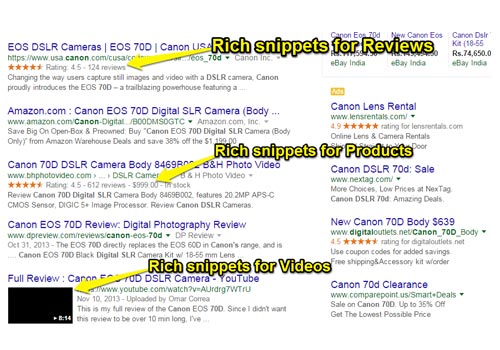Many website owners and online marketers are becoming interested in microformats and other forms of structured markups. What is particularly interesting about them is that they provide publishers a means to give search engines useful information about their website. One of the oldest ways of doing this is through metatags (title & description), which were unfortunately so badly abused by spammers, especially META description, that it lost value as a ranking signal. Even so, markups still offer significant value in terms of search engine optimization.
Rich Snippet Mark-up in Search Results

One of the many benefits of using markups is its positive impact in the appearance of your website’s search listings. Rich Snippet is a form of on-page mark-up that appears as extra bits of text under search results. They are the bacon bits of search engines that help draw the human eye to positive highlights of your web pages, thus increasing your click through rates for such results. Modified listings like these provide an extra pop of flavor that helps differentiate your search results from the plain old potato under or even above you in SERPs. Whether or not rich snippets are worth the extra trouble of tweaking your markups is a matter of your need to make your listing stand out. If you want to get your content noticed, rich snippets will definitely do the job for you.
Searchers’ eyes are drawn towards these extra bits of text, which not only make listings look different, but provide them (as well as search engines) additional insight into what your website and pages can offer. If this isn’t enough reason to make you want to consider Rich Snippets in your SEO strategy, try doing a basic search for any topic and notice how websites with rich snippets easily beat plain old potatoes in terms of rankings.
Types of Rich Snippets and How to Implement Them
There are several types of rich snippet markups you can use for your website, ranging from breadcrumb links to events, music, organizations, people, products, recipes, review ratings, reviews, software applications, and videos. Implementing rich snippets is as easy as picking a data format and including your chosen mark-up in your content. Google recommends using microdata (as outlined at schema.org), although any of the following formats are acceptable: microdata, microformats, or RDFa. The beauty of using rich snippets is that you need no prior knowledge of these formats, as they can easily be implemented using your basic knowledge of HTML. Once your content has been marked up, you can test it using Google’s structured data testing tool.
Snippets can likewise be used by online merchants to give Google detailed information about products. Using markups will enable you to attract potential buyers when searching for items to buy via search engines, control your product information, and maintain the freshness and accuracy of your product data so consumers can find the relevant and current items they are searching for. Examples of rich snippets that can be displayed with product pages include price, review ratings, and product availability.
Rich snippets are not just a cool thing for your website’s ego nor are they just eye candies to draw users’ attention from your competitors to your results. They potentially increase click through rates and effectively lower the chances of users bouncing, since they have more information on what they can expect on your page before they even click through. Rich snippets provide quality results that are closer to their specifications.
Curious about what rich snippets and markups can do for your SEO efforts? Contact SEOValley™ today to know more.





